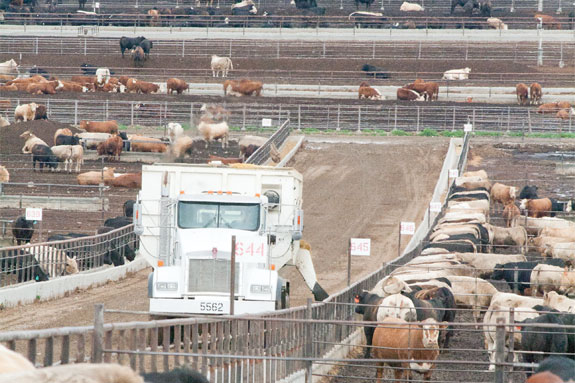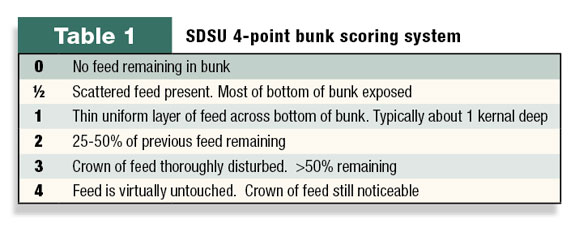We always hope for a magic bullet – something that hasn’t been thought of or discussed yet, and can “cure all ills.”
While a myriad of technologies and tools are available for all production phases and can have a definite impact on enhancing performance and profitability, ultimately some of the most basic approaches that have been discussed time and time again rise to the forefront as successful strategies.
While not a novel concept, sound bunk management is a tool that can be utilized by cattle feeders to enhance profitability in several ways.
To illustrate the time-tested philosophy of sound bunk management, I would like to offer a quote from W.A. Henry in the 1898 edition of “Feeds and Feeding,” which has become the slogan for many professionals covering the topic: “The eye of the master fattens his cattle.”
The root of this statement is that feeding cattle is really as much art as it is science. To obtain the “master” title, cattle feeders may have had to endure tough times and learn things the hard way.
In today’s market environment – when we’re dealing with feed costs near or exceeding all-time highs – the goal of today’s producers is to shorten the learning curve and employ systems that avoid the school of hard knocks.
In order to understand why bunk management is crucial in allowing cattle to reach their genetic potential for performance, we should first understand a key point:
Cattle are ruminant animals and the rumen serves as a fermentation point for ingested feed. Ask brewmasters the key to successful fermentation and they will invariably answer with “consistency.”
Cattle perform best when diets are consistent and fed in consistent amounts with prescribed increases at consistent times. Substantial variation – in any of these areas – is the number one enemy.
To illustrate this point, let’s go back to 1907 when Herbert Mumford said, “As soon as the fattening process begins, the cattle should be fed at certain hours in the same way.
This cannot be varied 15 minutes without some detriment to the cattle. The extent of injury will depend upon the frequency and extent of irregularity.” Delivering feed to the cattle is the last point we have to influence them from a nutritional perspective.
The most popular form of bunk management is clean or slick bunk management and has become the norm for successful cattle feeders across the country. In clean bunk management, intakes are controlled.
But unlike limit feeding, they are not inevitably reduced. Put simply, this strategy matches the amount of feed delivered with the amount the cattle can handle.
This is where the art of cattle feeding comes into play. Because factors like cattle type, feedstuffs available, formulation strategies and management practices vary so much, it’s difficult to prescribe clean bunk management guidelines suitable for all cattle feeders.

Having said this, Dr. Mike Galyean from Texas Tech University conducted a survey in 1996 and asked consultants representing 3.5 million head of cattle what their views were on different management practices. Opinions differed in regards to their recommendations on implant programs, protein and roughage levels in diets and vitamin supplementation, to name a few.
However, all consultants surveyed believed that controlled bunk management was an essential component that can influence feed intake and gain.
Clean bunk management systems have demonstrated that long-term intake and gain typically meet or exceed that of cattle fed ad-libitum. Z.I.
Prawl and co-workers at Oklahoma State University in 1997 demonstrated enhanced gains, feed conversion and dressing percentage with numerical improvements for intake, carcass weight and ribeye area.
The response in enhanced performance is probably two-fold. First, this strategy may result in a decreased rate of acidosis, which would leave cattle feeling better and avoiding peaks and valleys in intake patterns throughout the feeding period.
Secondly, competition among cattle for feed (versus having all they want at any time) seems to drive cattle to eat more. Keep in mind, it is important that all cattle have access to eat their share throughout the day.
To make this system a success, accurate records and communication between bunk readers and feed mixing/delivery personnel are vital.
Knowing cattle weight, age and consumption history allows for accurate feed calls. Let the cattle guide you in your decision, not command it.
As a rule of thumb, Johnny Horton of Nutrition Services Associates, an independent consulting firm from Hereford, Texas, suggests you are at the right level of intake when 25 percent of the cattle are lined up at the bunk, 50 percent are standing and working their way toward the bunk and 25 percent are getting up and stretching as the mixer approaches.
Evaluate the manure as a barometer for progress. Robbi Pritchard of South Dakota State University outlines that flat, brown stools are good; flat, gray stools signify that cattle are being pushed too hard; and predominantly flat, brown stools with a few grays smattered about lets us know that we are on the proper side of optimizing performance.
A final point to consider is weather. Just because cattle either act overly hungry or back away from the bunk does not mean that an inaccurate feed delivery has been made.
Aside from gross errors in feed calls or mixing, most metabolic issues typically take two to three days to manifest themselves. Weather effects seem to be more abrupt.
Extremes in weather patterns should be factored into the equation when making calls for subsequent feedings. It goes without saying that ration presentation should be palatable, fresh and thoroughly mixed.

To provide some guidance and a unit of measure, workers at South Dakota State University have created the 4-Point Bunk Scoring System (Table 1).
The goal of this system is to allow feeders to measure how much of the delivered ration cattle are consuming, not just how much was fed.
This history, along with visual appraisal of cattle behavior, stools and weather factors, can assist the feeder in making an accurate feed call and allow for optimum cattle performance.
An added benefit of implementing sound bunk management practices is reduction in feed waste or spoilage. When the proper amount of feed is delivered to the cattle, the need for manually shoveling or cleaning bunks is all but eliminated.
Once again, the key to a successful program is designing a system that best fits your specific operation and production goals. Work with your consultant to explore and implement a sound bunk management program on your operation. ![]()
PHOTOS
TOP: Accurate communication between bunk readers and feed mixing/delivery personnel is vital for clean bunk management. Photo by Ray Merritt
BELOW: Competition among cattle for feed (versus having all they want at any time) seems to drive cattle to eat more. Photo by Show Me Agri Comm.

Chad Howlett
Beef Technical Manager
Vita Plus
chowlett@vitaplus.com






